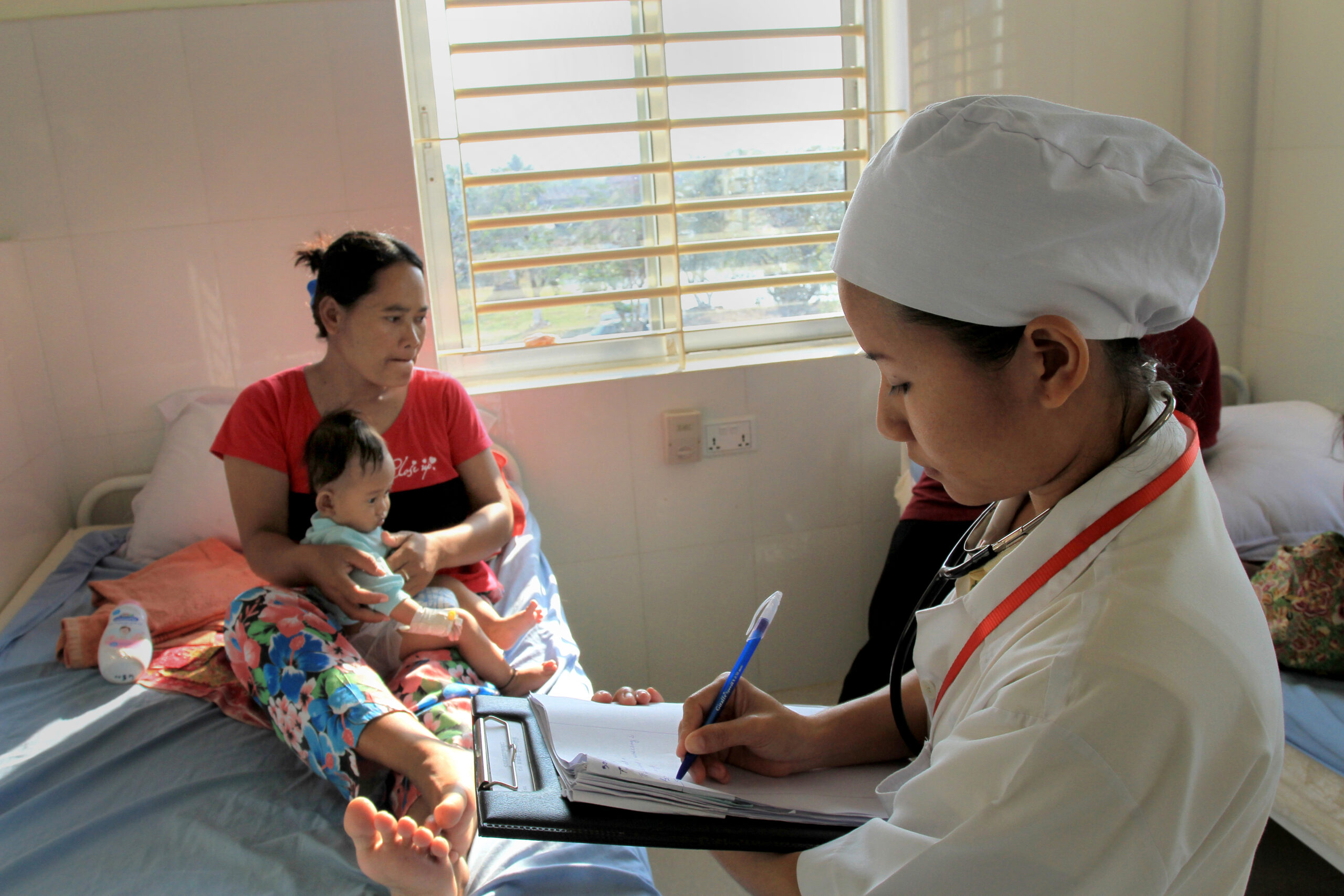ប្រព័ន្ធសុខាភិបាលប្រកបដោយគុណភាព និងប្រសិទ្ធភាពដែលផ្តល់លទ្ធភាពទទួលបានសេវាកម្មស្មើភាពគ្នាមានសារៈសំខាន់ណាស់ដើម្បីធានាបាននូវសុខុមាលភាពរបស់ប្រជាជនក្នុងប្រទេសមួយ។ ទាំងប្រទេសអភិវឌ្ឍន៍ និងប្រទេសកំពុងអភិវឌ្ឍន៍ខិតខំធ្វើឱ្យប្រសើរឡើងនូវប្រព័ន្ធសុខាភិបាលរបស់ពួកគេ។ ជាពិសេសប្រទេសកម្ពុជាបានឆ្លងកាត់ការផ្លាស់ប្តូរយ៉ាងច្រើនទាក់ទងនឹងការថែទាំសុខភាពដែលជាលទ្ធផលនៃការពង្រីកសេដ្ឋកិច្ចយ៉ាងឆាប់រហ័សនាពេលថ្មីៗនេះ។1 ចាប់តាំងពីទសវត្សឆ្នាំ ១៩៩០ ប្រទេសកម្ពុជាបានចាត់វិធានការ និងយុទ្ធសាស្ត្រសំខាន់ៗឆ្ពោះទៅការកែលំអប្រព័ន្ធសុខាភិបាល និងគោលនយោបាយរបស់ខ្លួន ដើម្បីធានាបាននូវសុខុមាលភាពរបស់ប្រជាពលរដ្ឋ។2 ទោះបីជាមានការផ្លាស់ប្តូរគួរឱ្យកត់សម្គាល់ក៏ដោយ ស្ថានភាពសុខភាពទូទៅរបស់ប្រជាជនក្នុងរយៈពេលប៉ុន្មានទសវត្សរ៍ចុងក្រោយនេះ ភាពខុសគ្នា និងបញ្ហាប្រឈមនានានៅតែមាន។ ជាការឆ្លើយតបប្រទេសកម្ពុជាបាននឹងកំពុងអនុវត្តគោលនយោបាយសុខាភិបាលថ្មី ដើម្បីកែលម្អការផ្តល់សេវា។ ហិរញ្ញប្បទានសុខភាពបានឆ្លងកាត់ការផ្លាស់ប្តូរតួនាទីរបស់ខ្លួនយ៉ាងសំខាន់ ក្នុងការកែលំអការផ្តល់សេវាថែទាំសុខភាពនៅកម្ពុជា។
ហិរញ្ញប្បទានសុខាភិបាលបានឆ្លងកាត់ការផ្លាស់ប្តូរតួនាទីយ៉ាងសំខាន់របស់ខ្លួនក្នុងការសម្រួលការផ្តល់សេវាថែទាំសុខភាពនៅកម្ពុជា។ រដ្ឋាភិបាលកម្ពុជាអាចបង្កើនហិរញ្ញប្បទានសុខភាពពី ១០៥៧ លានដុល្លារក្នុងឆ្នាំ ២០១៤ (ដោយសារការពង្រីកសេដ្ឋកិច្ចរបស់ប្រទេស) ដល់ ១២០៧ លានដុល្លារក្នុងឆ្នាំ ២០១៧។3 ចំនួននេះគឺច្រើនជាង ៧% នៃផលិតផលក្នុងស្រុកសរុបរបស់កម្ពុជា ហើយអាចធ្វើទៅបានតាមរយៈការធ្វើពិពិធកម្មប្រភពហិរញ្ញវត្ថុ រួមមានពន្ធអាករ ម្ចាស់ជំនួយពីប្រទេសខាងក្រៅ ការចំណាយចេញពីហោប៉ៅផ្ទាល់ខ្លូន និងធានារ៉ាប់រងសុខភាពដូចបានបង្ហាញក្នុងរូបភាពទី ១។4
យោងតាមរូបភាពនេះ ការចំណាយចេញពីហោប៉ៅផ្ទាល់ខ្លូនគ្របដណ្តប់ស្ទើរតែទាំងស្រុងនៃប្រាក់ចំណូលសរុប ដែលមានចំនួនប្រមាណ ៦១,៣% បន្ទាប់មកគឺជំនួយអភិវឌ្ឍន៍ផ្លូវការដែលស្មើ ២០,២% នៃចំណូលសរុប។ ថវិការដ្ឋាភិបាលមានចំនួន ១៩,៣% និង ថ្លៃធានារ៉ាប់រងសុខភាពប្រមាណ ០,២%។
រូបភាពទី ២ បង្ហាញពីផ្នែកយ៉ាងធំនៃថវិកាសរុបបានចំណាយទៅលើឱសថ និងសេវាថែទាំសុខភាពផ្សេងទៀត ចំនួន ៤១,៨% ប្រាក់ខែបុគ្គលិក និងថ្លៃចំណាយលើបុគ្គលិកតមានចំនួន ២៥,២% ។ បន្ទាប់មកផ្នែកខ្លះនៃចំណាយសរុប គឺត្រូវចំណាយលើការវះកាត់ និងប្រតិបត្តិការផ្សេងៗដែលគិតជាភាគរយស្មើ ១៨,៨% និងចុងក្រោយគីចំណាយមូលធន ១៣,៧%។
ធនធានដែលត្រូវបានទំនុកបំរុងសម្រាប់ការថែទាំសុខភាពក៏បានជួយក្នុងការកសាងហេដ្ឋារចនាសម្ព័ន្ធសុខភាព និងធនធានមនុស្សឡើងវិញផងដែរ។ បន្ទាប់ពីរបបខ្មែរក្រហម ប្រទេសកម្ពុជានៅសល់តែវេជ្ជបណ្ឌិតចំនួន ២៥ នាក់ប៉ុណ្ណោះ។5 ប្រទេសកម្ពុជាបានអនុវត្តផែនការកម្លាំងពលកម្មសុខាភិបាលចំនួនពីរ ដើម្បីបង្កើនកម្លាំងពលកម្មតាមរយៈកម្មវិធីជ្រើសរើស និងការបណ្តុះបណ្តាលធនធានមនុស្ស ដោយសារតែចំនួនអ្នកជំនាញមិនគ្រប់គ្រាន់សម្រាប់ប្រជាជនចំនួន ១៦ លាននាក់។ ប្រទេសកម្ពុជាបានបង្ហាញពីតំរូវការរបស់ខ្លូនដើម្បីទទួលបានបុគ្គលិកសុខាភិបាលចំនួន ៣២,០០០ នាក់នៅឆ្នាំ ២០២០។6 នៅឆ្នាំ ២០១៨ កម្ពុជាមានបុគ្គលិកសុខាភិបាលជាង ២៩០០០ នាក់ដូច្នេះធ្វើឱ្យមានការរីកចម្រើនយ៉ាងខ្លាំងឆ្ពោះទៅរកទិសដៅឆ្នាំ ២០២០ របស់ខ្លួន។7
កំណែទម្រង់ប្រព័ន្ធសុខាភិបាលដែលបានចាប់ផ្តើមនៅទសវត្សឆ្នាំ ១៩៨០ បានបង្កើតនូវរចនាសម្ព័ន្ធបីជាន់ដូចពេលបច្ចុប្បន្នក្នុងឆ្នាំ ១៩៩៦ ដោយបែងចែកការទទួលខុសត្រូវនៅថ្នាក់កណ្តាល ខេត្ត និងស្រុក8 លំដាប់ថ្នាក់ទាំងនេះត្រូវបានកំណត់ដោយទំនួលខុសត្រូវផ្សេងៗគ្នា ហើយត្រូវធ្វើការរួមគ្នា ដើម្បីធានាបាននូវការផ្តល់សេវាសុខភាពល្អប្រសើរ។ នៅខាងលើគឺថ្នាក់កណ្តាលដែលមានក្រសួងសុខាភិបាលនិងវិទ្យាស្ថានជាតិដែលជួយបង្កើតគោលនយោបាយ។ នៅខាងលើគឺថ្នាក់កណ្តាលដែលមានក្រសួងសុខាភិបាល និងវិទ្យាស្ថានជាតិដែលជួយបង្កើតគោលនយោបាយ ច្បាប់ និងយុទ្ធសាស្ត្រ។ នៅកម្រិតមធ្យម គឺជាថ្នាក់ទីពីររួមមានមន្ទីរសុខាភិបាលខេត្ត និងមន្ទីរពេទ្យដែលភ្ជាប់ពីថ្នាក់កណ្តាលទៅស្រុកប្រតិបតិ្តការ និងអនុវត្តគោលនយោបាយជាតិ។ កម្រិតក្រោមបំផុតមានក្រុមប្រតិបត្ដិការស្រុក មន្ទីរពេទ្យបង្អែក មណ្ឌលសុខភាព និងប៉ុស្តិ៍សុខភាព។9 ការអភិវឌ្ឍនៃថ្នាក់ទាំងនេះគឺមានសារៈសំខាន់ក្នុងការធ្វើវិមជ្ឈការការផ្តល់សេវារដ្ឋបាល ហេតុដូច្នេះការបង្កើនគុណភាពក្នុងការផ្តល់សេវាកម្ម និងជម្រុញកិច្ចសហប្រតិបត្តិការរវាងវិស័យឯកជន និងសាធារណៈ គឺដើម្បីអាចផ្តល់សេវាកម្មនៅកម្រិតសហគមន៍បាន។
បច្ចុប្បន្ននេះ ដោយសហការជាមួយដៃគូអភិវឌ្ឍន៍ រដ្ឋាភិបាលកម្ពុជាកំពុងអនុវត្តផែនការយុទ្ធសាស្ត្រសុខាភិបាលលើកទី ៣ ឆ្នាំ ២០១៦-២០២០ របស់ខ្លួនHSP3)10 ការគ្រប់គ្រងយុទ្ធសាស្ត្ររបស់ក្រសួងសុខាភិបាលមួយនេះត្រួសត្រាយផ្លូវសំរាប់វិស័យសុខាភិបាលរបស់ប្រទេសក្នុងការចល័ត ធនធានដែលមាន ហើយប្រើវាប្រកបដោយភាពយុត្តិធម៍ ដើម្បីសំរេចបាននូវលទ្ធផលល្អក្នុងការផ្តល់សេវាសុខាភិបាល។ ផែនការនេះក៏ជាការចង្អុលបង្ហាញពីការប្តេជ្ញាចិត្តរបស់រដ្ឋាភិបាលក្នុងការពង្រឹងប្រតិបត្តិការក្នុងការផ្តល់សេវាថែទាំសុខភាព ផ្តល់អាទិភាពដល់សេវាកម្មសំខាន់ៗ និងធ្វើឱ្យមានយុទ្ធសាស្ត្រសមស្របសម្រាប់កម្មវិធីផ្សេងៗ។ ផែនការនេះបង្ហាញពីក្របខ័ណ្ឌសម្រាប់តាមដានការអនុវត្តរួមជាមួយគោលដៅផ្សេងទៀត ដូចជា ការកៀរគរធនធានហិរញ្ញវត្ថុ ការណែនាំ ការបែងចែកប្រាក់ចំណូល និងការណែនាំជំនួយអភិវឌ្ឍន៍ក្នុងវិស័យសុខាភិបាលរបស់ប្រទេស។11
តាមរយៈក្រសួងសុខាភិបាល រដ្ឋាភិបាលក៏បានដាក់ចេញនូវយន្តការសំខាន់ៗសម្រាប់ការជូនដំណឹងទាក់ទងនឹងការផ្ទុះឡើងនៃជំងឺ។ ប្រទេសកម្ពុជាមានប្រព័ន្ធគ្រប់គ្រងព័ត៌មានសុខាភិបាល (HMIS) ដើម្បីធ្វើប្រតិបត្តិការឃ្លាំមើលប្រជាពលរដ្ឋ និងឃ្លាំមើលការរីករាលដាលនៃជំងឺ ដោយផ្តល់ឱ្យក្រសួងសុខាភិបាលនូវព័ត៌មានសំខាន់ៗដើម្បីត្រៀមរៀបចំឱ្យបានទាន់ពេលវេលា។12

គិលានុប្បដ្ឋាយិកាកំពុងពិនិត្យមើលទារកដែលមានជំងឺនៅក្នុងមណ្ឌលសុខភាពក្នុងស្រុកមួយឯខេត្តព្រះវិហារ។ រូបថតដោយ ឆ សុគន្ធា / ធនាគារពិភពលោក ថតនៅថ្ងៃទី ៣០ ខែមករាឆ្នាំ ២០១៣។ ក្រោមអាជ្ញារបណ្ណ CC BY-NC-ND 2.0.
ពេលខ្លះប្រទេសកម្ពុជាត្រូវបានរងផលប៉ះពាល់ដោយជំងឺឆ្លង ដោយសារស្ថានភាពអនាម័យមិនល្អនៅកន្លែងខ្លះ។ ការឆ្លងមេរោគតាមទឹកដូចជាជំងឺរាគរូស (ហើយក្នុងករណីដ៏កម្របំផុត, អាសន្នរោគ) ប៉ះពាល់ដល់មនុស្សមួយចំនួនដែលជាលទ្ធផលនៃកង្វះអនាម័យនិង ពិសារទឹកដែលគ្មានសុវត្ថិភាព។ ការឆ្លងទាំងនេះ បានជម្រុញរដ្ឋាភិបាលកម្ពុជាឱ្យបង្កើតប្រព័ន្ធឃ្លាំមើលដើម្បីជួយក្នុងការគ្រប់គ្រងការផ្តល់សេវាថែទាំសុខភាព តាមរយៈការរកឃើញការផ្ទុះនៃជំងឺ ដោយការប្រមូលទិន្នន័យពីមន្ទីរពេទ្យជាតិ និងមណ្ឌលសុខភាព។ ការច្នៃប្រឌិតថ្មីនៅក្នុងបច្ចេកវិទ្យាព័ត៌មានវិទ្យាបាននាំឱ្យមានការប្រើប្រាស់កម្មវិធី camEWARS ដូច្នេះធ្វើឱ្យប្រសើរឡើងនូវប្រសិទ្ធភាពនិងភាពទាន់ពេលវេលានៅពេលប្រមូលទិន្នន័យទាក់ទងនឹងការផ្ទុះជំងឺ។ ការច្នៃប្រឌិតថ្មីនៅក្នុងបច្ចេកវិទ្យាព័ត៌មានវិទ្យាបាននាំឱ្យមានការប្រើប្រាស់កម្មវិធី camEWARS ដែលអាចធ្វើឱ្យប្រសើរឡើងនូវប្រសិទ្ធភាព និងភាពទាន់ពេលវេលានៅពេលប្រមូលទិន្នន័យទាក់ទងនឹងការផ្ទុះជំងឺ។
ដូចជាគុណភាពទឹកមិនល្អ គុណភាពខ្យល់មិនល្អ ក៏អាចបង្កបញ្ហាផងដែរ។ គ្រួសារភាគច្រើនជាពិសេសនៅតាមទីជនបទ ប្រើប្រាស់ប្រេងឥន្ធនៈជីវម៉ាសសម្រាប់ចម្អិនអាហារដែលជាហេតុធ្វើឱ្យមានករណីឆ្លងជំងឺផ្លូវដង្ហើមច្រើនជាពិសេសក្នុងចំណោមកុមារ។
ប្រទេសកម្ពុជាមានធម្មនុញ្ញហិរញ្ញប្បទានសុខាភិបាលដែលផ្តល់នូវក្របខ័ណ្ឌយុទ្ធសាស្ត្រ និងការលើកលែងចំពោះប្រជាជនក្រីក្រពីថ្លៃសេវាសុខភាព។ ចំណុចនេះមានសារៈសំខាន់ណាស់ក្នុងការអនុញ្ញាតឱ្យការផ្តល់សេវាថែទាំសុខភាពដល់ប្រជាជនដែលជួបការលំបាកក្នុងប្រាក់ចំណូល ដើម្បីបង្កើនការផ្តល់សេវាសុខភាពនៅកម្ពុជា។13 ប្រមាណជា ១៨% នៃអ្នកជំងឺដែលមកព្យាបាលនៅមណ្ឌលថែទាំសុខភាពគឺមកពីគ្រួសារក្រីក្រ។ គម្រោងមូលនិធិសមធម៌សុខាភិបាល ផ្តល់នូវមធ្យោបាយដ៏មានប្រសិទ្ធិភាពក្នុងការផ្គត់ផ្គង់ដល់ប្រជាជនក្រីក្រ ដោយសារតែការគាំទ្ររបស់ម្ចាស់ជំនួយយ៉ាងច្រើនបានបញ្ជូនឆ្ពោះទៅរកការផ្តល់សេវាសុខភាពដល់បុគ្គលដែលជួបការលំបាកផ្នែកហិរញ្ញវត្ថុ។ គម្រោងមូលនិធិសមធម៌សុខាភិបាលគ្របដណ្តប់ជាង ៥០% នៃវិស័យសុខាភិបាលនៅកម្ពុជាទាំងអស់ ដែលចូលរួមនូវចំណែកដ៏សំខាន់ដល់ប្រជាជនដែលជួបការលំបាកក្នុងការរកប្រាក់ចំណូល។14
រដ្ឋាភិបាលក៏បានចាប់ផ្តើមនូវរបបសន្តិសុខសង្គម ដែលក្នុងនោះមានកម្មវិធីព្យាបាលរបួស និងប្រាក់សោធនសំរាប់មនុស្សចាស់។ សមាសភាពប្រជាសាស្ត្រនៅកម្ពុជាមានការផ្លាស់ប្តូរយ៉ាងឆាប់រហ័សដោយសារតែការកើនឡើងនៃចំនួនប្រជាជនវ័យចំណាស់ដែលទាមទារឲ្យមានសេវាកម្មថែទាំរយៈពេលវែង។ ភាពងាយរងគ្រោះរបស់ក្រុមអាយុមួយនេះ និងបញ្ហាជំងឺដែលមិនឆ្លងអាចបង្កើនអត្រាមរណភាពក្នុងប្រទេសកម្ពុជាបាន។ អត្រាមរណភាពពីជម្ងឺមិនឆ្លងបានកើនឡើងពី ៣២% ទៅ ៥២% ក្នុងចន្លោះឆ្នាំ ២០០០ និង ២០១៣ ដែលជះឥទ្ធិពលយ៉ាងធ្ងន់ធ្ងរដល់មនុស្សវ័យចំណាស់15 ការធានារ៉ាប់រងសុខភាពសង្គមក៏ត្រូវបានបង្កើតឡើងដើម្បីលើកកម្ពស់ការទទួលបានការថែទាំសុខភាពស្មើភាពគ្នាជួយកាត់បន្ថយការចំណាយក្នុងគ្រួសារលើការថែទាំសុខភាព និងលើកកម្ពស់ការផ្តល់សេវាថែទាំសុខភាពនៅក្នុងប្រទេស។
សរុបសេចក្ដីមក ប្រទេសកម្ពុជាបានផ្តួចផ្តើមគំនិតសំខាន់ៗដើម្បីធានាបាននូវការផ្តល់សេវាសុខភាពប្រសើរជាងមុន តាមរយៈការធ្វើកំណែទម្រង់គោលនយោបាយ និងការគ្រប់គ្រងសុខភាពរបស់ខ្លួន។ រដ្ឋាភិបាលបានបង្កើនហិរញ្ញប្បទានសុខភាពតាមរយៈបណ្តាញជាច្រើន ដូចជាការយកពន្ធ និងការបរិច្ចាគ ដើម្បីផ្តល់នូវឧបករណ៍សុខាភិបាល និងសេវាកម្មសុខាភិបាលចាំបាច់។ ចំពោះផ្នែកធនធានមនុស្សវិញ អ្នកជំនាញសុខាភិបាលកាន់តែច្រើនកំពុងត្រូវបានបណ្តុះបណ្តាល ដើម្បីធានាថាមានបុគ្គលិកពេទ្យគ្រប់គ្រាន់សំរាប់បំពេញតម្រូវការប្រជាជនដែលកំពុងកើនឡើងនៅកម្ពុជា។ ប្រទេសកម្ពុជាក៏បានឹងកំពុងអនុវត្តផែនការយុទ្ធសាស្ត្រសុខាភិបាលចំនួនពីរ ដើម្បីកែលំអការផ្តល់សេវាសុខាភិបាល និងប្រសិទ្ធភាពនៅកម្រិតខុសៗគ្នា។ ប្រតិបត្ដិការឃ្លាំមើលការផ្ទុះឡើងនៃជំងឺឆ្លងជាពិសេសការឆ្លងមេរោគពីទឹកដូចជាជំងឺអាសន្នរោគ គឺជាកត្តាសំខាន់ក្នុងការសំរេចឲ្យបាននូវសេវាសុខាភិបាលប្រសើរជាងមុន និងស្មើភាពគ្នា។ ធម្មនុញ្ញហិរញ្ញប្បទានសុខាភិបាលបានលើកកម្ពស់ការផ្តល់សេវាសុខភាពនៅកម្ពុជាបន្ថែមទៀត តាមរយៈការបង្កើនលទ្ធភាពទទួលបានការថែទាំសុខភាពក្នុងចំណោមប្រជាជនក្រីក្រ។
ទាក់ទងនឹងគោលនយោបាយ និងការគ្រប់គ្រងវិស័យសុខាភិបាល
ឯកសារយោង
- 1. Tim Ensor et al., “ផលប៉ះពាល់នៃគោលនយោបាយហិរញ្ញប្បទានសុខភាពនៅកម្ពុជា៖ បទពិសោធន៍ ២០ ឆ្នាំ,” វិទ្យាសាស្ត្រសង្គមនិងវេជ្ជសាស្ត្រ ១៧៧ (ថ្ងៃទី ២៦ ខែមករាឆ្នាំ ២០១៧): ទំព័រ. ១១៨-២២៦, https://doi.org/https://doi.org/10.1016/j.socscimed.2017.01.034
- 2. Rathny Suy et al., “គោលនយោបាយថែទាំសុខភាពកម្ពុជា៖ បញ្ហាប្រឈមនិងការអភិវឌ្ឍន៍,” ទិនានុប្បវត្តិអន្តរជាតិនៃមនុស្សសាស្ត្រនិងវិទ្យាសាស្ត្រសង្គមអនុវត្ត ២, លេខ២ (ថ្ងៃទី ២៨ ខែកុម្ភះឆ្នាំ ២០១៧) ទំព័រ. ២៣-៣២
- 3. Catherine Barker Cantelmo et al., “ការប៉ាន់ប្រមាណការចំណាយលើផែនការសុខភាពជាមួយនឹងឧបករណ៍ OneHealth ប្រទេសកម្ពុជា,” ព្រឹត្តិប័ត្ររបស់អង្គការសុខភាពពិភពលោកលេខ ៩៦
- 4. Rathny Suy et al., “គោលនយោបាយថែទាំសុខភាពកម្ពុជា៖ បញ្ហាប្រឈមនិងការអភិវឌ្ឍន៍,” ទិនានុប្បវត្តិអន្តរជាតិនៃមនុស្សសាស្ត្រនិងវិទ្យាសាស្ត្រសង្គមអនុវត្ត ២, លេខ២ (ថ្ងៃទី ២៨ ខែកុម្ភះឆ្នាំ ២០១៧) ទំព័រ. ២៣-៣២
- 5. ibid
- 6. ibid
- 7. គំរោងជំនួយរបស់ទីភ្នាក់ងារ USAID, “ការសង្ខេបពីប្រទេសនីមួយៗ: កម្ពុជា”, ២០១៧, ទំព័រ ១៣
- 8. Rathny Suy et al., “គោលនយោបាយថែទាំសុខភាពកម្ពុជា៖ បញ្ហាប្រឈមនិងការអភិវឌ្ឍន៍,” ទិនានុប្បវត្តិអន្តរជាតិនៃមនុស្សសាស្ត្រនិងវិទ្យាសាស្ត្រសង្គមអនុវត្ត ២, លេខ២ (ថ្ងៃទី ២៨ ខែកុម្ភះឆ្នាំ ២០១៧) ទំព័រ. ២៣-៣២
- 9. ibid
- 10. Peter Leslie Annear, Bart Jacobs,និង Matthias Nachtnebel, “ការពិនិត្យប្រព័ន្ធសុខាភិបាលនៃព្រះរាជាណាចក្រកម្ពុជា” (ហ្សឺណែវ, ស្វីស៖ អង្គការសុខភាពពិភពលោក, ឆ្នាំ ២០១៥)
- 11. ibid
- 12. ibid
- 13. Annear et al.,“ការពារជនក្រីក្រ? ផលប៉ះពាល់នៃមូលនិធិសមធម៌សុខភាពជាតិ លើការប្រើប្រាស់សេវាសុខភាពរបស់រដ្ឋាភិបាលនៅកម្ពុជា, ២០០៦-២០១៣.” BMJ Global Health ៤,លេខ៦ (២០១៩): E001679
- 14. នាយកដ្ឋានផែនការនិងព័ត៌មានសុខភាព, “ផែនការសុខភាព ២០១៦-២០២០” (ក្រសួងសុខាភិបាល, ២០១៦)
- 15. ibid

